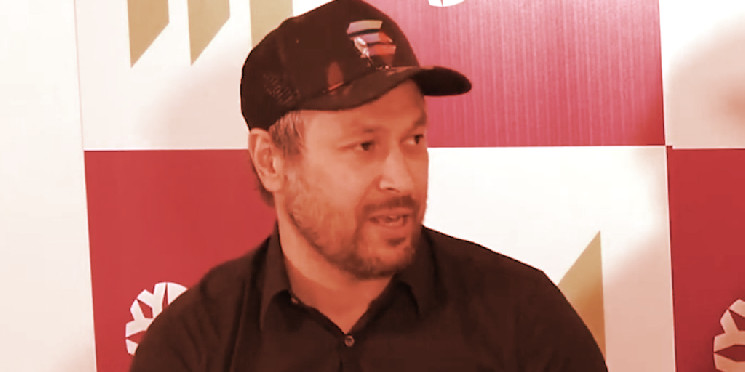Solana Founder: We’re More ‘Complementary’ to Ethereum Than ‘Killer’

«We do sometimes track our success against Ethereum in terms of developer adoption,» Solana Labs co-founder Anatoly Yakovenko acknowledged on the Decrypt gm podcast. «I think it’s really important because they are the market leader.»
Still, he said it has been interesting to see what kind of developers choose Ethereum over Solana, pushing back against the idea that Solana is an «Ethereum killer.»
«What’s funny to me is that people call Solana an Ethereum killer, but we’re so different,» he said, adding that the two proof-of-stake blockchains are «almost complementary» in many ways.
‘Ethereum Killer’ Solana Suffers Another Major Outage
Launched in March 2020, Solana is a popular blockchain for dapps and non-fungible tokens or NFTs due to its fast transaction speed. Like Ethereum post-merge, Solana uses a proof-of-stake consensus algorithm. Unlike a number of proof-of-stake blockchains, however, Solana is a mixed blockchain that also uses a proof-of-history consensus algorithm.
The idea behind proof-of-history is to provide a chronicle of previous events on the blockchain, ensuring that there’s a common record of what happened and when for permanent reference.
In Yakovenko’s opinion, Ethereum is focused on the idea that validators need to be extremely cheap. He said the developers are sacrificing everything else to achieve that, adding that Ethereum’s sharded network and its future plans are all based around the idea of very cheap validation.
«That opens up the space to a decentralized network optimized for consensus at the speed of light,» Yakovenko told Decrypt. «There are use cases that you can’t run on Ethereum that you can run on Solana, and this is where I start seeing devs really pick Solana over Ethereum.»
While Yakovenko says Ethereum and Solana are complementary, that doesn’t mean he believes in a multi-chain future.
«I don’t know what’s going to happen, if we’re gonna have a multi-chain future or not,» he said. «Right now, when you use an application, you’re still aware that you’re using a Solana or Ethereum application. And maybe users that are crypto-native care to make that distinction.»
Yakovenko pointed to the expanding NFT market and the growing number of new users entering the space.
«We’re seeing new [people] enter the space,» he said. «When we get to 100 million [active users], will that next 90 million care about which blockchain it’s using? They are going to be using the killer app that brought them there.»
It’s that killer app that defines the environment, Yakovenko says, which may lead to a world that’s not multi-chain but something more akin to Amazon Web Services (AWS) or cloud-based competitive distribution.
«That doesn’t mean that it won’t be a multi-chain world, but it may be a world where a very large portion of transactions, maybe 90% of transactions, occur on one environment,» he said.






 Bitcoin
Bitcoin  Ethereum
Ethereum  Tether
Tether  USDC
USDC  TRON
TRON  Dogecoin
Dogecoin  Cardano
Cardano  Bitcoin Cash
Bitcoin Cash  Chainlink
Chainlink  LEO Token
LEO Token  Monero
Monero  Stellar
Stellar  Zcash
Zcash  Litecoin
Litecoin  Hedera
Hedera  Dai
Dai  Cronos
Cronos  OKB
OKB  Tether Gold
Tether Gold  Ethereum Classic
Ethereum Classic  KuCoin
KuCoin  Gate
Gate  Algorand
Algorand  Cosmos Hub
Cosmos Hub  VeChain
VeChain  Dash
Dash  Tezos
Tezos  Stacks
Stacks  TrueUSD
TrueUSD  IOTA
IOTA  Basic Attention
Basic Attention  Decred
Decred  Theta Network
Theta Network  NEO
NEO  Synthetix
Synthetix  Qtum
Qtum  Ravencoin
Ravencoin  0x Protocol
0x Protocol  DigiByte
DigiByte  Zilliqa
Zilliqa  Nano
Nano  Holo
Holo  Numeraire
Numeraire  Siacoin
Siacoin  Waves
Waves  Ontology
Ontology  Enjin Coin
Enjin Coin  Status
Status  BUSD
BUSD  Pax Dollar
Pax Dollar  Hive
Hive  Lisk
Lisk  Steem
Steem  Huobi
Huobi  NEM
NEM  OMG Network
OMG Network  Augur
Augur  Bitcoin Gold
Bitcoin Gold  Ren
Ren  Bitcoin Diamond
Bitcoin Diamond